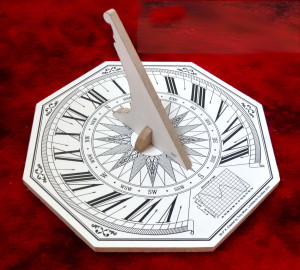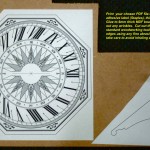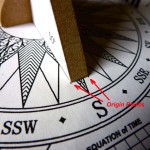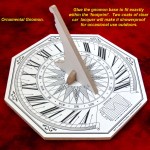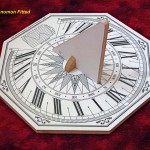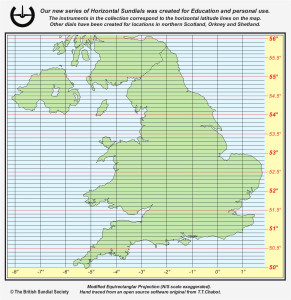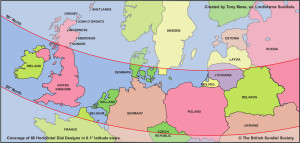The British Sundial Society’s range of 60 pre-designed horizontal sundials has an accurately designed version for every 0.1° of latitude between 50° and 56° north which covers England & Wales, Northern Ireland and much of southern Scotland including Edinburgh and Glasgow. In addition there are designs for Dundee, Aberdeen, Inverness, John O’Groats, Orkney and Shetland. Choose the design nearest to your latitude between 50°N and 56°N and it can never be more than 0.05° off correct calibration. All the designs are delineated in 3-minute intervals with traditional roman numerals and a choice of ornamental or simple gnomons.
Choose your Dial: The Latitude Finder page will help you select the correct dial for your location using the latitude bands shown on the map to the right. It also provides a download link for a PDF of the dial for your chosen position.
Although the many towns and cities in southern Scotland have been covered with sundials at 0.1° intervals, at this time it has not proved feasible to cover the north in similar detail. Dundee, Aberdeen, Inverness, John O’Groats, central Orkney and the Shetlands have dedicated sundials which can be adjusted for the intervening latitudes as follows. For every 0.1° your location may be to the south of e.g. Dundee, simply tilt the southern edge 0.1° upwards and it will read correctly. For locations to the north of Dundee tilt the northern edge upwards.
In the same way, the 50.0° dial for southern Cornwall can be adjusted for e.g. the Scillies by tilting its southern edge upwards by the same number of degrees as its displacement in latitude.
Although designed for the UK, these dials can be used in other locations. As an example, the lower image shows the use of the 50° to 56° dials across northern Europe and into Russia.
Printer Calibration: Laser printers tend to be more accurate than cheaper inkjet models and their output is less liable to smudging by moisture. After printing your chosen dial carefully measure across the octagonal edges North/South and East/West. If there is a big difference between the measurements your sundial may not work as it should so try other printers using a laser type if possible.
Construction: The dial is constructed by glueing the printed design (dial and gnomon) to 6mm MDF board, cutting out and assembling the pieces and coating the dial to make it showerproof. Details are provided in the following pictures:
After constructing the sundial for your latitude, but before beginning to set up and use it, you are strongly advised to consult How Sundials Work to see many well-illustrated examples together with a wealth of other dialling information.
Setting up and reading your BSS Horizontal Sundial
Sundial Time (Solar Time or Local Apparent Time) is usually out-of-step with Clock Time by an amount which varies throughout the year, The following notes will tell you how to incorporate this difference when setting up your sundial correctly. The TV Time signal or a radio controlled clock/watch are good sources of accurate ‘clock time’ to assist you.
- First of all look at the small ‘Equation of Time’ graph on your sundial face and note how many minutes should be added or subtracted from the dial reading for the current date. You will see that very near to the beginning of April approx. 3 minutes must be added to the dial reading (the dial is SLOW) whereas at the end of September approx. 10.5 minutes must be subtracted. (the dial is FAST)
- When the clock is reading e.g. 10.00am in early April we would have to set the sundial to read 09.57. In practice It is far easier to work the other way about and set the sundial to 10.00 when the clock is reading 10.03. Reverse this procedure when the Equation of Time is a negative value.
- All of the above will work very well if the day is reliably sunny but this is often not the case. Brief glimpses of clear sunlight often appear at very inconvenient times which makes juggling with mental arithmetic somewhat frantic. The easiest solution is to set a spare watch to today’s solar time then match the sundial to it when the Sun appears.
- Perhaps the easiest method of all is to use a wonderful software ‘app’ by Emerald Sequoia (free) called simply ‘Observatory’. The iPad version automatically sets itself to your exact location then the small dial marked ‘Solar’ is what your sundial should be reading on the current day. Set your dial on a surface which is truly level then rotate it to read the same time as the ‘Solar’ clock dial. The ‘compass rose’ and the gnomon ‘footprint’ on the dial plate will now align exactly with True North and your sundial is set up correctly.
- To read Clock Time directly from your newly setup sundial you must make one more correction unless you are actually located on the Greenwich 0° Meridian. For every degree to the west of 0° add four minutes to your sundial reading. Likewise four minutes must be subtracted for every degree to the east. When Daylight Saving is in operation an additional hour must be added to the sundial.
If you are happy with your dial please send small pictures of the result, with yourself or school class etc. included, to Tony Moss.
